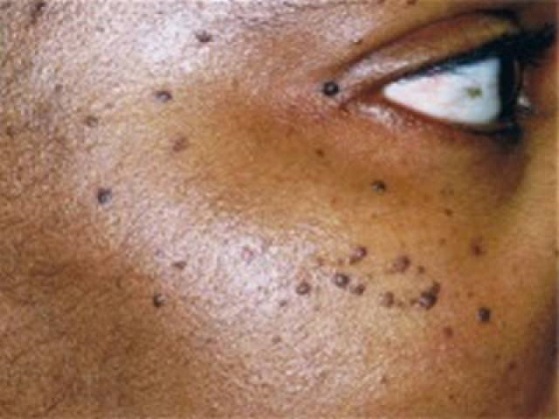

#SKIN TAGS ALL OVER NECK SKIN#
Atrophy: Skin that is paper-thin, transparent, and wrinkled.Wheal: An irregular-shaped, solid, elevated area that can vary in color and lasts for only a short time.Įxamples of secondary skin lesions include:.Tumor: A lesion that is larger than 0.5 centimeter (0.2 inch) in size but looks similar to a nodule.Telangiectasia: Clusters of "spider veins" where tiny blood vessels cause red lines on the skin.Nodule: A circular, elevated, solid bump greater than 0.5 centimeter (0.2 inch) in size.Pustule: Similar to a vesicle but filled with pus instead of fluid.Vesicle: A fluid-filled blister less than 0.5 centimeter (0.2 inch) in size.Plaque: A lesion that is raised like a papule and is greater than 1-2 centimeter (0.4 to 0.8 inch) in size.Patch: A flat lesion that is different in color and greater than 0.5 centimeter (0.2 inch) in size.Papule or maculopapular: An elevated solid lesion, up to 0.5 centimeter (0.2 inch) in size.Macule: A flat lesion that is different in color, and less than 0.5 centimeter (0.2 inch) in size.Cyst: A raised area of the skin that has clear borders and is filled with fluid or semi-solid fluid.Bulla: A vesicle that is more than 0.5 centimeters (0.2 inch) and is filled with fluid.Flat lesions: Examples include patches and macules.Lesions that are solid masses: Examples include nodules and tumors.Lesions formed by fluid within the skin layers: Examples include vesicles and pustules.Primary skin lesions tend to be divided into three groups: This can happen when a primary skin lesion is:įor example, if eczema is scratched, a crust may form. Secondary skin lesions arise from primary skin lesions. Jamie Weisman, Medical Dermatology Specialists, Inc.Skin lesions are either primary or secondary. Primary skin lesions are either present from birth or develop during your lifetime. To learn more about our skin tag treatment options, call us today. We also will help you prevent future ones as well. Medical Dermatology Specialists can accurately determine the cause of your skin tag and help you remove them. The rubbing and friction caused can create bleeding, irritation and even infection. While your skin tags are not dangerous, they can definetly be a nuisance as a woman who needs to wear a bra. In addition, overweight women who may raise and lift their arms may develop skin tags due to the constant friction around the breast area. If you’re a runner, the repetitive friction, tighter fitting running clothes and sports bras can contribute to the formation of skin tags. They also are more common starting after the age of 50. They typically show up on people with diabetes as well as obese or overweight individuals. A skin tag can be very bothersome if it is located around your bra strap or along your bra lines. They basically can show up on any area of your body that has folds. One other common area for skin tag growth in women is around the breast or bra area. Skin tags often show up around the eyelids, neck, groin and armpits.

It is likely that if you have no skin tags, you will most likely develop at least a few in your lifetime. They are harmless, but can be very annoying. Skin tags are small, soft, benign skin growths that are often on a stalk.


 0 kommentar(er)
0 kommentar(er)
